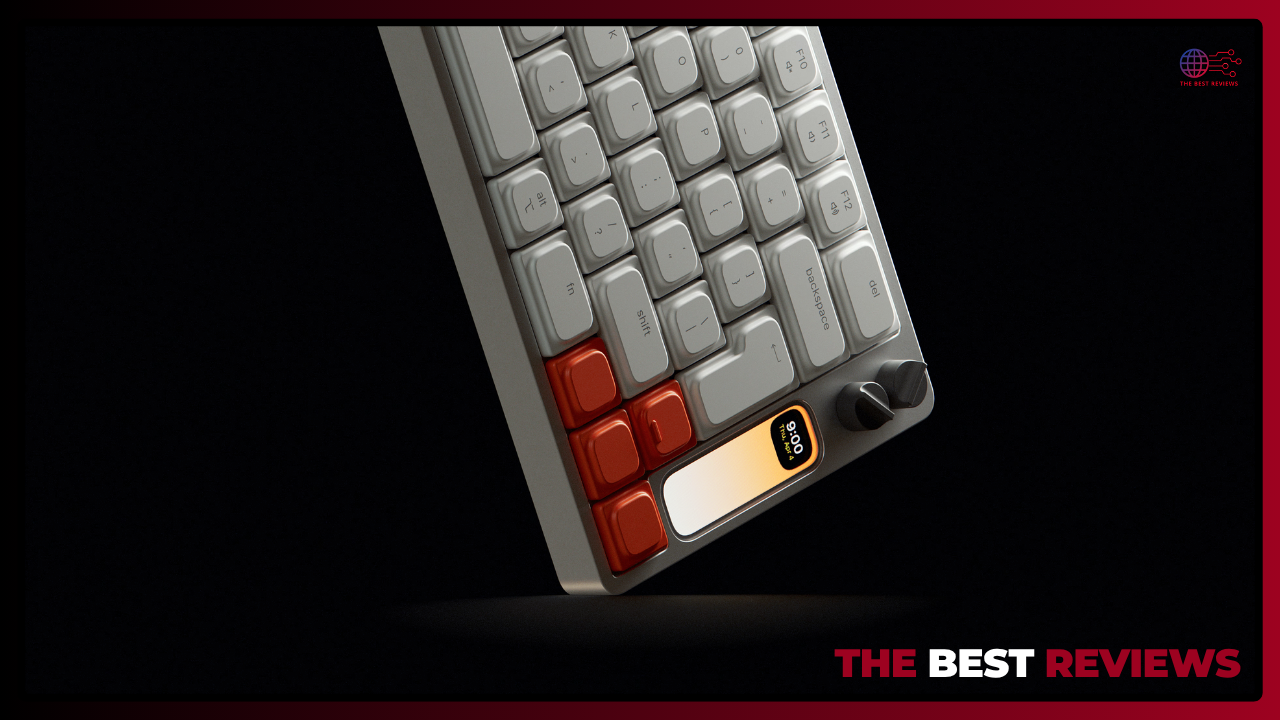Choosing the best keyboard for your PC is a decision that’s more important than you may first think.
After all, you’re going to sit in front of it for countless hours, so you deserve something that can accommodate your needs.
Basic keyboards are OK in a pinch, but they don’t prioritize features that will help you achieve your productivity goals, and they certainly don’t offer much in terms of ergonomics.
op-tier choices such as the Kinesis Freestyle2 offer across-the-board quality for managing workloads.
Not only is it reasonably priced, but it’s lightweight, comfortable to use, and delivers a great typing experience.
With multi-connectivity options and a 36-hour battery life, you also get the benefit of plenty of versatility. And with handy features like its mic mute button, it makes those remote meetings a breeze to handle.
If you’re looking for something a bit more budget-priced that doesn’t skimp on performance, the SteelSeries Apex Pro Gen 3 keyboard is a real winner.
This Cherry SX scissor-switch keyboard provides a fluid and comfortable typing experience and benefits from an easy-breezy setup. It might not be much of a looker, but it does a great job of balancing price and functionality.
Table of Contents
- Wooting 80HE
- NuPhy Field75 HE
- SteelSeries Apex Pro Gen 3
- Logitech MX Keys S
- Kinesis Freestyle2
TOP 5 BEST KEYBOARD 2025
1 : Wooting 80HE

The Wooting 80HE is a high-performance 80 % magnetic gaming keyboard that builds upon Wooting’s analog Hall‑effect legacy, all while addressing previous limitations .
delivers ultra‑low latency—up to 8 000 Hz polling and Rapid Trigger with 0.1 mm actuation—making keystrokes feel near-instant and highly customizable.
The Lekker V2 switches, gasket-mount design, and screw‑in stabilizers produce a satisfying “thocky” sound and comfortable typing feel, while Wootility software shines with intuitive mapping, gamepad emulation, SOCD settings, and per-key actuation.
Available in either a lighter PCR ABS plastic case ($199) or heavier zinc‑alloy version ($290), the board includes an LED bar for visual feedback and vibrant per‑key RGB.
Though it lacks wireless connectivity and its proprietary PCB limits aftermarket compatibility, these trade-offs are offset by class-leading gaming performance .
Some users do note chassis flex under heavy typing and an unconventional layout that isn’t true TKL .
Overall, the 80HE stands as one of the most capable wired gaming keyboards in 2025, ideal for enthusiasts who prioritize speed and customization.
Pros
- Wooting’s Wootility software provides granular control over RGB lighting, actuation points, and other settings, allowing for personalized gaming experiences.
- The 80HE generally produces a quiet and pleasant typing sound, especially with the zinc alloy case.
- The keyboard boasts a premium feel, whether with the plastic or zinc alloy case, and features smooth switches and well-lubricated stabilizers.
Cons
- Some users have reported sticky stabilizers, which may require adjustments like removing fabric tape or re-lubing.
- The 80% layout, while offering a good balance, might not appeal to all users, especially those who heavily rely on standard key positions.
- The 80HE’s cost, especially the zinc alloy version, can be a significant barrier to entry, with rivals offering similar functionality at lower prices.
2 : NuPhy Field75 HE
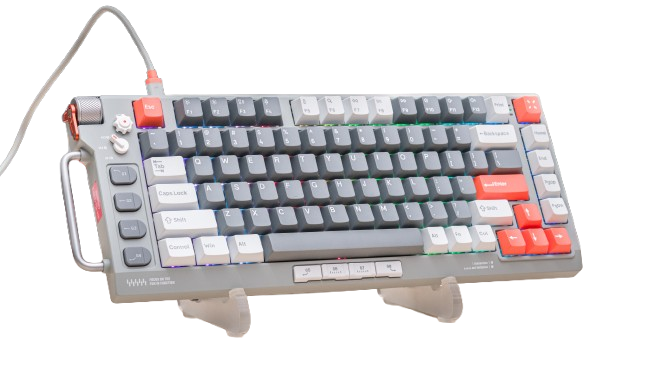
The Field75 HE excels in responsiveness, thanks to its Hall‑Effect (Gateron Magnetic White or Jade) switches and ultra‑fast 8 000 Hz polling rate, delivering sub‑1 ms latency and flawless NKRO—ideal for competitive gaming .
Features like Rapid Trigger, Snap‑Tap, and per‑key adjustable actuation provide supreme customization. Build Quality & Design Sporting a solid plastic/aluminum frame with pre‑lubed PBT keycaps, plate-mount stabilizers.
extra a volume wheel, RGB dial, and even a LAN‑party-style handle, this keyboard is brimming with practical extras rtings.com.
The firmware can be configured via the intuitive web app NuPhyIO Typing & Comfort Typing feels snappy and accurate, but the light actuation (as low as 0.1 mm) can cause typos and finger fatigue during longer sessions.
The stock tray‑mount layout is firm; comfortable typing may require tweaking actuation or adding a wrist rest.
Downsides Wired‑only, despite featuring a carrying handle Non‑shine‑through keycaps: not ideal in low light Sensitive switches may require actuation tuning to reduce mispresses Verdict If you’re after cutting‑edge gaming performance, versatile Hall‑Effect customization, and premium build, the Field75 HE is a standout.
But if wireless freedom, deep typing comfort, or backlit legends are deal‑breakers, you may be better off with alternatives like the Keychron K2 HE or Q1 HE.
Pros
- The Field75 HE stands out with its distinct design and vibrant RGB lighting, making it a visually appealing option.
- The dedicated volume knob and brightness dial provide tactile and precise control.
- The Field75 HE excels in gaming with its impressive latency performance and 8000Hz polling rate, offering a responsive and consistent experience.
Cons
- The keyboard doesn’t have exceptional sound dampening, which can result in a plasticky sound character during typing.
- The typing feel is described as stiff, which may not be preferred by all users.
- The keyboard uses a cabled connection, which may be a drawback for users who prefer a wireless setup.
- Some users find the typing experience on Hall effect switches to be less satisfying than traditional mechanical switches, with a potentially hollower sound and lack of tactile bump.
3 : SteelSeries Apex Pro Gen 3
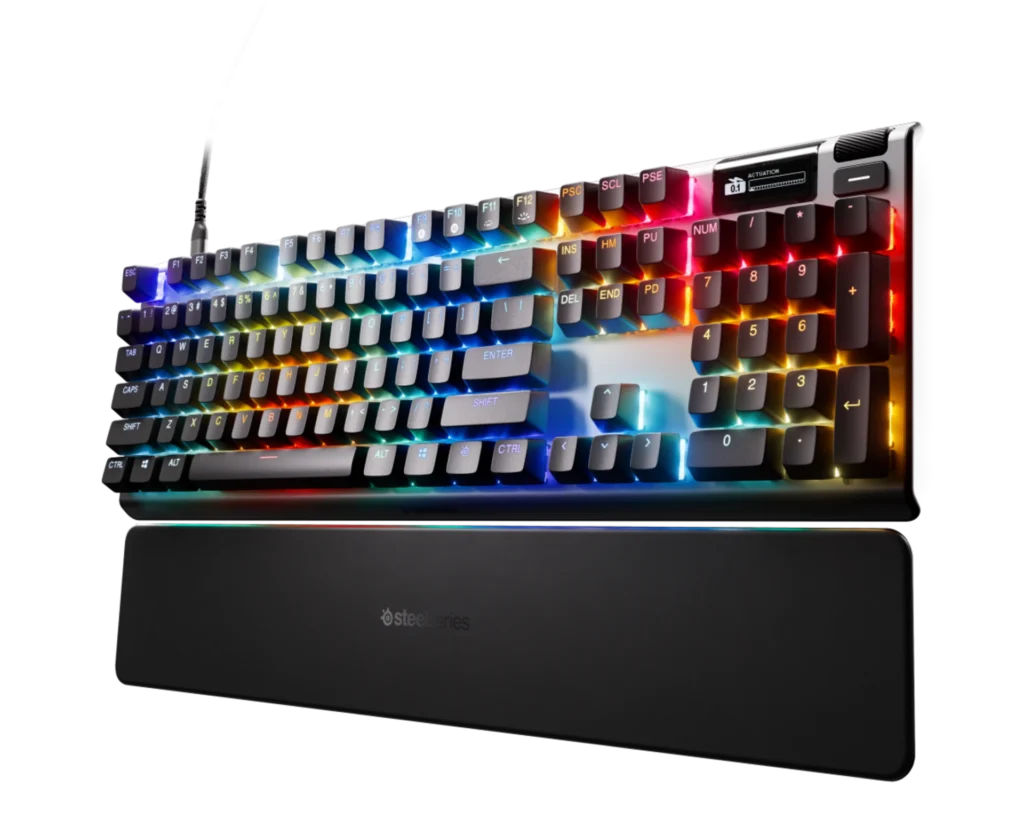
The Apex Pro Gen 3 excels with its OmniPoint 3.0 Hall‑Effect switches, offering 40 levels of adjustable actuation (0.1–4 mm), delivering up to 20× faster actuation and 11× faster response compared to traditional mechanical switches.
Its Rapid Trigger and Rapid Tap features cater to competitive gamers who demand ultra-fast keypresses, while Protection Mode helps prevent mispresses during intense play.
Build quality is top‑tier: aircraft-grade aluminum chassis, triple-layer sound-dampening foam, per-key lubrication, improved stabilizers, and premium PBT (or ABS depending on model) keycaps create a satisfyingly “thocky” yet refined typing experience.
The OLED smart display adds flair and function—showing media info, profile and actuation settings—while the detachable USB‑C enhances portability.
On the downside, it comes at a premium price (~$240 full-size), has a steeper learning curve, and only alphanumeric keys use Hall-effect switches—others remain standard mechanical.
Some users report occasional connection issues with the wireless model or quirks in SteelSeries GG software. For discerning gamers and typists, the Apex Pro Gen 3 delivers cutting‑edge speed, premium construction, and deep customization—making it one of the most advanced keyboards available in 2025.
If you want professional-level performance and don’t mind the price or setup complexity, this keyboard is a stellar choice.
Pros
- SteelSeries Engine software offers a range of customization options and features for both gaming and general use.
- SteelSeries Engine software offers a range of customization options and features for both gaming and general use.
- The keyboard is known for its sturdy construction and premium feel.
- This feature eliminates latency from key deactivation, making it ideal for fast-paced games that require quick and repeated actions
Cons
- Some users have reported the SteelSeries Engine software can be clunky or buggy.
- The keyboard is considered expensive, especially for a wired-only model.
- While the adjustable actuation is a key feature, some users have reported inconsistencies in the accuracy of actuation settings, which can be a problem for competitive gaming.
4 : Logitech MX Keys S
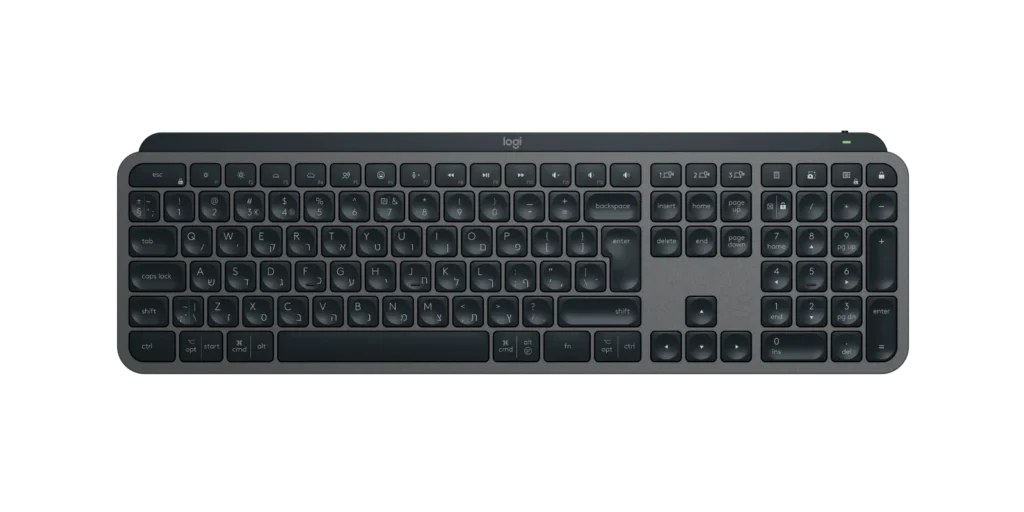
The MX Keys S is Logitech’s premium low-profile wireless keyboard aimed at professionals and multitaskers.
It features scissor‑switch, chiclet-style keys with concave caps that deliver a quiet and precise typing experience—with a feel akin to Apple’s Magic Keyboard, but at a slightly lower price point.
Ergonomics & Build Low-slung design with slight wrist tilt and a stable, rubber-gripped base.
The optional palm rest further improves comfort over long sessions. Smart Features Adaptive backlighting (hand‑proximity + ambient sensors), plus dedicated keys for dictation, mute, emoji, and Smart Actions via Logi Options+—enabling macros and multi‑step commands.
Connectivity Connects via Bluetooth or Logi Bolt USB dongle to three devices and switches between them effortlessly.
Battery Up to 10 days with backlight or around 5 months without. Some users report 14–16 day runtime with moderate use.
Backlight Often criticized as dim and inconsistent, even at max brightness.
Key Durability Reports of keycaps wearing or breaking after ~1–2 years; replacements are available only through third-party sources. Form Factor Quirks Large size lacks dongle storage; top‑row keys are tightly packed and default to media functions, which some find awkward.
Price: At ~$109+, it’s costlier than comparable mechanical alternatives that offer hot-swappable switches. If you prioritize quiet, comfortable typing, smart automation, and multi-device fluency—and don’t mind occasional quirks like dim backlight or premium price—the MX Keys S is a superb choice for productivity. However, durability concerns and lack of dongle storage may dissuade users seeking long-term resilience or portability.
Pros
- The Logitech Options+ software allows for customization of shortcuts and actions, enhancing productivity.
- It can connect to multiple devices via Bluetooth and switch between them easily.
- The MX Keys S boasts a solid, durable construction.
Cons
- Some users prefer the keycap shape and higher profile of the original MX Keys over the S version.
- While good for general use, the latency may be too high for competitive or fast-paced gaming.
- The MX Keys S is considered expensive compared to other wireless keyboards.
5 : Kinesis Freestyle2
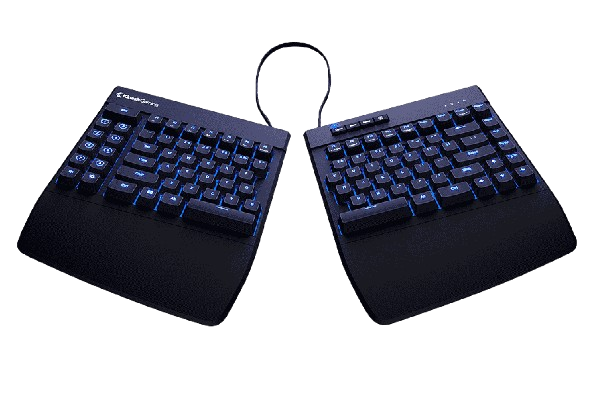
The Kinesis Freestyle2 is a standout ergonomic keyboard designed to prioritize comfort and reduce strain during long typing sessions.
Its unique split design allows users to position each half independently, promoting a more natural hand, wrist, and shoulder alignment.
The low-profile keys and soft keypress feel contribute to a quiet and responsive typing experience, while the thin, lightweight build makes it ideal for both office and remote setups.
The Freestyle2 offers excellent customization with optional accessories like tenting kits and palm supports, catering to users with specific ergonomic needs.
Though it lacks backlighting and mechanical switches, it’s a solid choice for those prioritizing ergonomics over flashy features. Compatibility is broad, with both Windows and Mac versions available.
Overall, the Freestyle2 remains a top pick in 2025 for professionals seeking comfort and productivity, especially those dealing with repetitive stress injuries or looking to prevent them through better typing posture.
Pros
- The Cherry MX Brown switches on the Freestyle Pro offer a tactile bump, which can enhance the typing feel.
- Accessories like the VIP3 or V3 allow for various tenting angles (5, 10, or 15 degrees).
- The split and tenting design of the Freestyle2 allows for customizable angles and separation, potentially reducing wrist and shoulder strain
Cons
- The Freestyle Pro has limited customization options compared to some other ergonomic keyboards.
- The Freestyle Pro lacks USB ports on the back of the keyboard, unlike the standard Freestyle2.
- Some users have reported a squeaky typing experience and lower quality keycaps on the Freestyle Pro.
The Best Keyboards for 2025
Maybe your trusty old keyboard has typed its last letter or trapped its last bagel crumb.
Perhaps your gaming ambitions have outstripped the mushy, mediocre typer that came with your PC.
Or maybe your aching hands are shouting Hey, cut me some slack here! Whatever the reason, anyone can benefit from a better keyboard
Before you go shopping, however, it pays to know what makes a keyboard a good fit.
Modern models come in a bunch of subtypes, from boards optimized for typing efficiency to sculpted ergonomic designs that cradle your hands and relieve stress on the joints. Let’s dig into the features to look for.
Do I Need a Wired Keyboard, or a Wireless One?
The simplest way to connect a keyboard to your PC is to plug its cable into a USB port. Non-gaming keyboards are usually plug-and-play devices, with no additional software to install, so connecting the cable is all the setup you’ll need. Gaming keyboards, by contrast, will typically work as soon as you plug them in, but most come with their own software that lets you adjust features such as onboard RGB lighting and the assignment of macro keys. (More on that in a minute.) Some cheaper gaming models may lack software and handle key backlighting and macros/shortcuts wholly through hardware.
Besides transferring your keystrokes to the computer, a USB connection also powers the keyboard, so there are no batteries to worry about. Some premium gaming models with lots of customizable buttons and lights come with two USB cables, one for power delivery (and/or to feed an extra USB port or ports on the keyboard itself) and one for your data connection. This isn’t usually a problem, since you’ll likely be connecting one of these keyboards to a large gaming desktop with many available USB ports.
What Kind of Keyboard Layout Makes Sense for Me?
Not all keyboards are created equal. In fact, not all keyboards are even laid out the same (and we’re not referring to the standard QWERTY key layout versus the Dvorak arrangement of some early ergonomic models).
Most mainstream and gaming keyboards offer a 10-key numeric keypad at right. Rarely found on laptops smaller than 15.6 inches, keypads are a necessity for anyone who frequently tallies numbers or enters data into a spreadsheet. So-called tenkeyless or TKL models, especially popular in the gaming keyboard segment, slice off the numeric pad in the interest of saving desk space and keeping your typing and mousing hands closer together. If you want to go even smaller, so-called 60% keyboards eliminate even more extra keys. Check out our for everything you need to know about them.
What Should I Look for in a Gaming Keyboard?
While all keyboards offer the necessary QWERTY layout of keys for everyday typing, sometimes typing isn’t your main concern. are designed for competitive use and emphasize things office keyboards don’t.
Gaming boards are equipped for maximum specialization and control, optimized for specific styles of gameplay, and built to exacting standards of responsiveness and durability. They also appeal to the gaming aesthetic with designs that impress and intimidate with pulsing backlighting and dramatic RGB color schemes.
Premium gaming models almost exclusively use high-grade mechanical and sculpted keycaps, and offer scads of customizable features such as programmable macro keys, textured WASD keys, and swappable keycaps. Others let you tweak the color and intensity of the backlighting to make finding certain keys faster and personalize the look of your keyboard. Cheaper boards usually have just one color of backlight, but as you move upmarket you find programmable RGB lighting customizable by zone or even by individual key (so-called “per-key RGB”).
So, Which Keyboard Should I Buy?
The keyboard market is vast, so start your search with our picks outlined up top of the best keyboards available.

